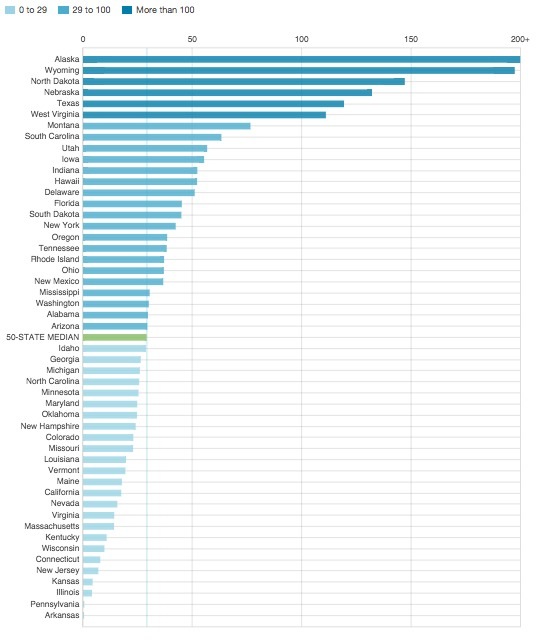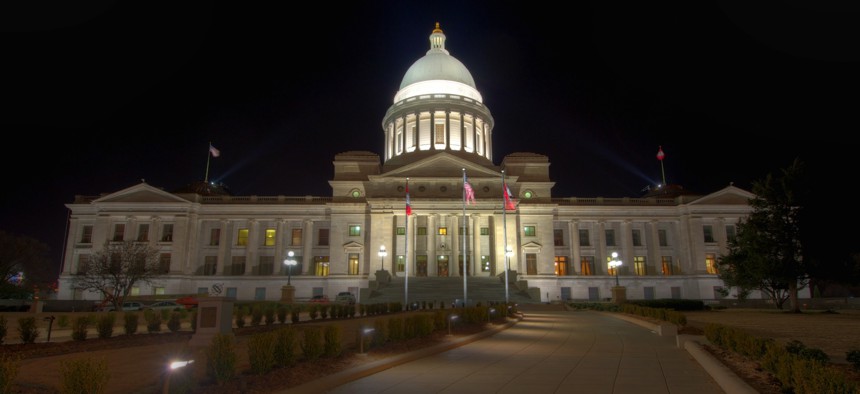Connecting state and local government leaders
Projections for fiscal 2016, the current budget year, show decreasing median reserves for the 45 state governments that reported complete data, with 34 state budgets anticipating lower levels relative to operating expenditures than in fiscal 2015.
States have made halting progress in rebuilding their financial cushions since the Great Recession. Overall, states had enough money in general fund budget reserves in fiscal year 2007—just before the economic downturn—to run government operations for a median of 41.3 days, but only 29.1 days in fiscal 2015.
For many states, even pre-recession reserve levels were inadequate to plug huge budget gaps that opened because of the 2007-09 recession. Still, only 18 states in fiscal 2015 could cover more days’ worth of operating costs with their reserves—counting both rainy day funds and general fund end-of-year balances—than before the recession, according to data collected by the National Association of State Budget Officers (NASBO).
There was an uptick from fiscal 2014 to 2015 in the median number of days that states could operate just on their reserves, as 26 states reported an increase in overall reserves relative to operating expenditures. That expansion resumed a trend that occurred from fiscal 2011 to fiscal 2013. States’ financial cushions had fallen in 2014, when officials looked to end-of-year balances to make up for a slowdown in tax collections.
Projections for fiscal 2016, the current budget year, show decreasing median reserves for the 45 states that reported complete data, with 34 state budgets anticipating lower levels relative to operating expenditures than in fiscal 2015. Those projections, however, are based on amounts appropriated in state budgets and routinely change significantly by the close of the fiscal year.
Download the Data | Fiscal 50 Interactive Tool
Highlights below ...

State Highlights
Fiscal 50’s state-to-state comparisons are based on the latest revised results for fiscal 2015. Among noteworthy findings:
- Once again, Alaska (447.0 days) had the largest reserves as a share of operating costs, though the state’s financial cushion has fallen each year since fiscal 2011 because of declining crude oil revenue. Even after lawmakers drew down about a third of the state’s rainy day funds to shore up retirement accounts and cover a budget shortfall in fiscal 2015, Alaska’s reserves still covered more days’ worth of spending than those of any other state.
- Five other states also had more than 100 days of operating costs in reserves: Wyoming (197.5 days), North Dakota (147.2 days), Nebraska (132.2 days), Texas (119.4 days), and West Virginia (111.1 days).
- The smallest reserves—less than five days’ worth of operating costs—were in Arkansas (0 days), Pennsylvania (0.1 days), Illinois (4.1 days), and Kansas (4.4 days). Kansas became the newest member of this group after its reserves—composed entirely of ending balances because the state does not maintain a rainy day fund—fell precipitously in fiscal 2015 relative to operating expenditures.
- Four states’ reserves could cover more days’ worth of operating costs than at any point since at least 2000: New York (42.4 days), Rhode Island (37.1 days), Texas (119.4 days), and Utah (56.8 days).
- In one state—Nevada—the capacity of reserve funds fell to the lowest level since the start of the recession: 15.7 days.
- For the third straight year, no state expected its reserves and balances to drop below zero. After the recession, Arizona, California, Connecticut, Kansas, Oregon, Pennsylvania, and Washington emptied their reserves in at least one year, requiring them to borrow or transfer cash to cover operating costs.
- The 18 states in which reserves were higher than pre-recession levels relative to operating costs were Alaska, Hawaii, Indiana, Iowa, Michigan, Nebraska, New York, Ohio, Rhode Island, South Carolina, South Dakota, Texas, Utah, Vermont, Washington, West Virginia, Wisconsin, and Wyoming.
Rainy Day Funds vs. End-of-Year Balances
Since declining in the recession, states’ financial cushions in aggregate have improved largely because of growth in rainy day funds—sometimes known as budget stabilization funds—rather than in end-of-year balances, which have been more volatile. A general fund ending balance is the amount left at the close of a fiscal year in what functions as a state’s main checking account, making it sensitive to year-to-year changes in revenue and spending.
States’ rainy day funds in fiscal 2015 totaled $44 billion, which could cover a smaller share of day-to-day government expenditures than in fiscal 2013 and 2014 but more than in the years immediately preceding the Great Recession. The decline in fiscal 2015, from $47.7 billion in fiscal 2014, was heavily driven by a $5.5 billion withdrawal in Alaska, without which the national total would have increased, because 29 states stowed away more funds.
Meanwhile, states’ total end-of-year balance, which reached $30.7 billion in fiscal 2015, was lower than at the pre-recession peak, measured in both nominal dollars and as a share of expenditures. However, the end-of-year balance was up from fiscal 2014 ($24.5 billion) by more than enough to offset the dip in rainy day funds. For 27 states, end-of-year balances rose in fiscal 2015 from the prior year. Much of the aggregate increase came from $4.7 billion in one-time money that New York collected from legal settlements it reached with financial institutions.
States use reserves and balances to manage budgetary uncertainty, deal with revenue forecasting errors, prevent severe spending cuts and tax increases, and cope with unforeseen emergencies. Because reserves and balances are vital for managing unexpected changes and maintaining fiscal health, their levels are tracked closely by bond rating agencies. For example, Moody’s Investors Service recently cited increasing reserves as one reason it upgraded Hawaii’s credit rating outlook to positive from stable.
Building up reserves and balances is a sign of fiscal recovery, but there is no one-size-fits-all rule about when, how, and how much to save. According to a December 2015 report by The Pew Charitable Trusts, Why States Save: Using Evidence to Inform How Large Rainy Day Funds Should Grow, the optimal savings target of state rainy day funds depends on three factors: the explicitly defined purpose of funds; the volatility of a state’s tax revenue; and the level of coverage—similar to an insurance policy—that the state seeks to provide for its budget.
This measure does not take into account additional resources that some states may have available to soften downturns, such as dedicated reserves outside their general funds or rainy day accounts, so it may not reflect a state’s complete fiscal cushion. In addition, some states undertake considerable spending outside the general fund, so comparisons across states should be made with caution.
Download the data to see individual state trends. Visit The Pew Charitable Trusts’ interactive resource Fiscal 50: State Trends and Analysis to sort and analyze data for other indicators of state fiscal health.
Alex Boucher and Matt McKillop work for The Pew Charitable Trusts, where this article originally appeared as part of the States' Fiscal Health initiative.

NEXT STORY: Coming Jan. 20: A Viewcast on Route Fifty’s State and Local Government Management Challenges Survey



